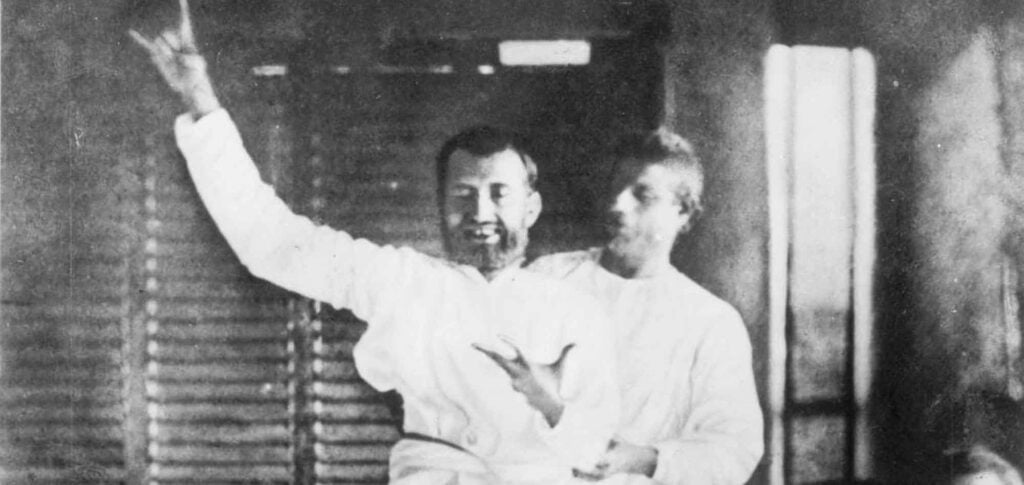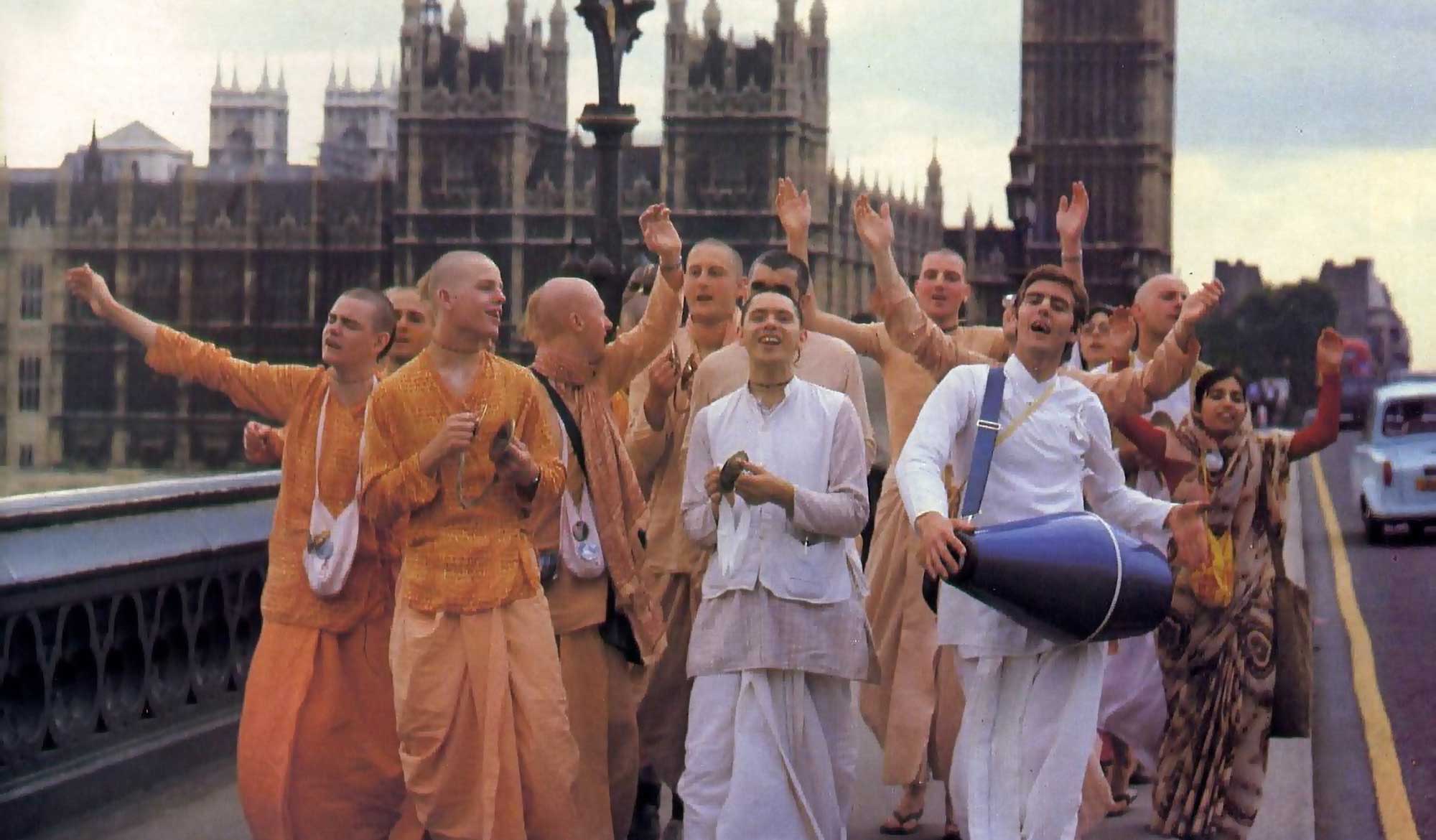Overview
Śrī Śrī Abhirāma Gosvāmī was first published in Sajjana Toṣaṇī Vol.2 issue 5 in 1885. In this short biography, Bhaktivinoda Ṭhākura tells the story of Abhirāma Ṭhākura and how he tested Śrīnivāsa Ācārya.
(translated by Swami B.V. Giri)
This issue is called the ‘Abhirāma issue.’ This year the festival of Abhirāma Gopāla is on the 8th of the month of Jyeṣṭha, on the Saptamī day. Abhirāma’s residence is at Śrīpāṭa Khānākula in Kṛṣṇanagara, in Hooghly District, under the jurisdiction of Jāhānābād police station. Abhirāma was the dear confidential friend of Śrī Śrī Mahāprabhu and Śrī Śrī Nityānanda Prabhu. The name of Abirāma’s wife was Śrīmatī Mālinī Devī. Mālinī was a great Vaiṣnavī, and due to this she was very dear to Abhirāma. Abhirāma installed the Deity of Śrī Śrī Gopīnātha. From time to time, Nityānanda Prabhu used to go to the residence of Abhirāma and play various sports in the mood that he previously had (as a cowherd boy). One day, while playing with Nityānanda, Abhirāma was overcome with sakhya-rasa and wanted to play the flute. But since no flute could not be found there, he lifted a piece of wood that hundreds of people were unable to carry, and in this way, he held it in both hands, considering it to be a flute. Everyone was amazed at this sight.
eka dina premānanda mata abhirāma
karena nartana se bhaṅgimā anupāma
(“One day Abhirāma felt great prema and began to dance in an incomparable way.”)
sakhya-rasāveśe vaṁśī bājāite chāya
iti iti phire nija vaṁśī nāhi pāya
(“Absorbed in sakhya-rasa, he desired to play a flute, yet despite his attempts he could not find one.”)
śatāvadhi jane yāre nāre cālāite
hena kāṣṭe vaṁśī kari dharilena hāte
(“He took a piece of wood in his hands that hundreds of people could not have lifted, and used it as a flute.”)
tāhā dekhi sabe mahā vismita hailā
madhye madhye ecche taṅāra alaukika līlā
(“Everyone that saw his miraculous līlā was extremely surprised.”) *
* Bhakti-ratnākara 4.121-124
Abhirāma Ṭhākura was extremely eager to give tests. He often tried to test the Vaiṣṇavas in one way or another. Once Śrī Śrīnivāsa Ācārya Prabhu wanted to visit him, but when he came there, Abhirāma did not meet him, but sent a servant with 10 kāḍis* and said, “Take these and do some service.” Śrīnivāsa, after purchasing the food items with those 10 kāḍis, cooked near the Dārukeśvara River, and offered the food to Śrī Kṛṣṇa.
* Translators Note: In medieval India, a kāḍi was a shell which was a medium of exchange in Bengal and Orissa.
At that time Abhirāma sent four guests to him. Śrīnivāsa smiled to himself, offered prasāda to the four of them, and then ate prasāda himself. The four persons, rejoicing at having the darśana of Śrīnivāsa, returned to Abhirāma and offered continuously offered praise. Then Abhirāma brought Śrīnivāsa in front of him and laughing, he took his whip which was named ‘Jaya-maṅgala’ (in his previous form as Śrīdāma in Vṛndāvana, he held this whip for tending the cows), and struck him three times on his body. As he went to beat him again, Śrīmatī Mālinī Devī came and grabbed his hand, saying, “Prabhu! Do not whip him again. You have shown enough of your mercy to him. Calm down now. Śrīnivāsa is just a boy – he can’t take any more.” Abhirāma, hearing Mālinī’s words, refrained from beating him and embraced him. Along with his wife, the placed their hands on his head, and with a content heart, they blessed him.
śrīnivāsa āilā jāni hāse manda manda
parīkṣā kariba mane kaila anubandha
(“Knowing that Śrīnivāsa had come, he laughed gently and out of affection, he decided to make a test.”)
daśa kaḍā kaḍī dilā nirvāha karite
ihaṅ yathā yogya dravya kinila tāhāta
(“He gave him ten kāḍis to do something with. With that he purchased some items.”)
tathā dārukeśvara nadera tīre gelā
randhana kariya kṛṣṇe bhoga samarpilā
(“He went to the bank of the Dārukeśvara River, cooked and then offered the bhoga to Kṛṣṇa.”)
hena kāle ṭhākura pāṭhāilā cāri-jana
tā dekhiyā śrīnivāsa ullāsita mana
(“At that time, the Ṭhākura sent four men, and seeing them Śrīnivāsa felt happy within.”)
praṇamiyā cāru-jane tāhā bhuñjāilā
āpani-u sei mahā-prasāda pāilā
(“Offering respects to those respectable persons, he fed them and then partook of the mahā-prasāda himself.”)
śrīnivāsa carite sabāra harṣa hiyā
ṭhākure kahaye āilām tṛpta haiyā
(“They were all happy with the character of Śrīnivāsa, and returned to the Ṭhākura and told him with eagerness.”)
e saba parīkṣā anye śikṣā karāite
śrīnivāse ānaila āpana sākṣāte
(“All this was a test for others to learn. Then he brought Śrīnivāsa and met with him.”)
śrī-jaya-maṅgala nāme cāruka tāṅhāra
śrīnivāsa aṅge sparśāila tinbāra
(“With his whip named Jaya Maṅgala, he beat Śrīnivāsa three times on his body.”)
manera ullāse se cāruka sparśāiyā
khala khala hāse śrīnivāse kichu kaiyā
(“He felt great ecstasy as he beat him with the whip, and as he spoke to Śrīnivāsa, he laughed.”)
premāveśe se cāruka puna sparśāite
śrī-mālinī devī āsi dharilena hāte
(“Absorbed in prema, as he was about to whip him again, Śrī Mālinī Devī came and grabbed his hand.”)
mālinī kahaye dhairya karaha gosāi
kailā anugraha ye tāhāra sīmā naī
(“Mālinī said, ‘O Gosāi, be tranquil! He cannot take so much mercy.”)
śrīnivāsa bālaka nāribe sthira haite
preme mata haile kārya sādhibe ki mate
(“’Śrīnivāsa is just a boy. If he becomes absorbed in prema, how will he do any service?’”)
eche paraspara kahe prasanna hiyāya
doṅhe hasta dhare-śrīnivāsera māthāya
(“They were both satisfied and they placed their hands upon the head of Śrīnivāsa) *
* Bhakti-ratnākara 4.132-144













